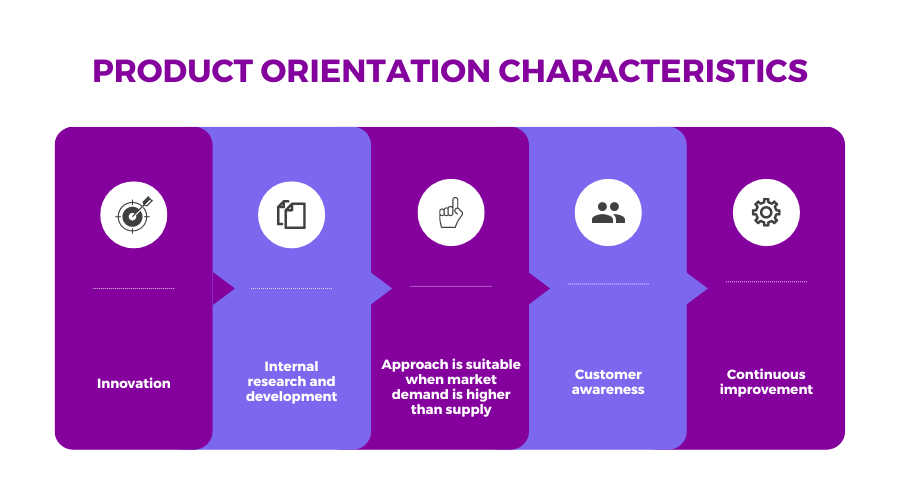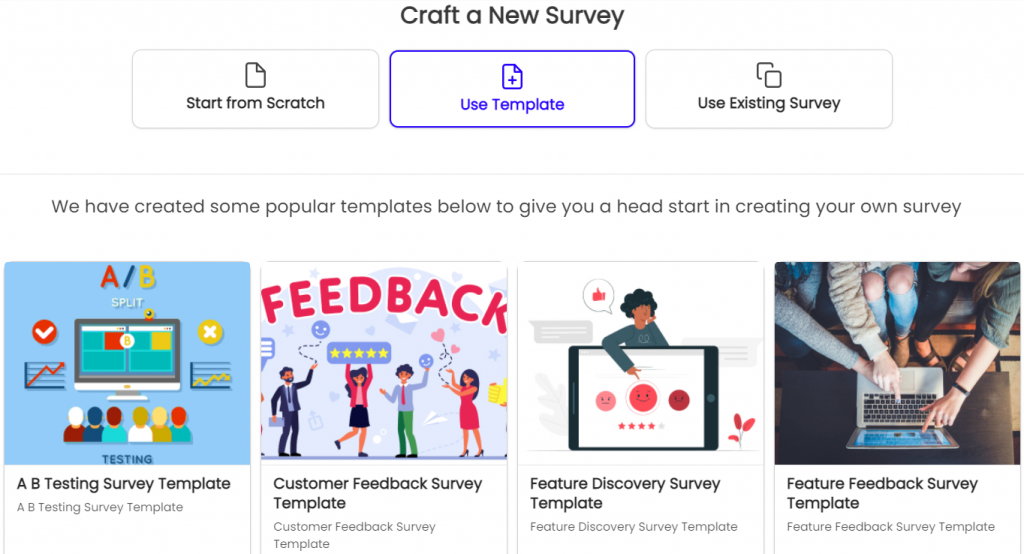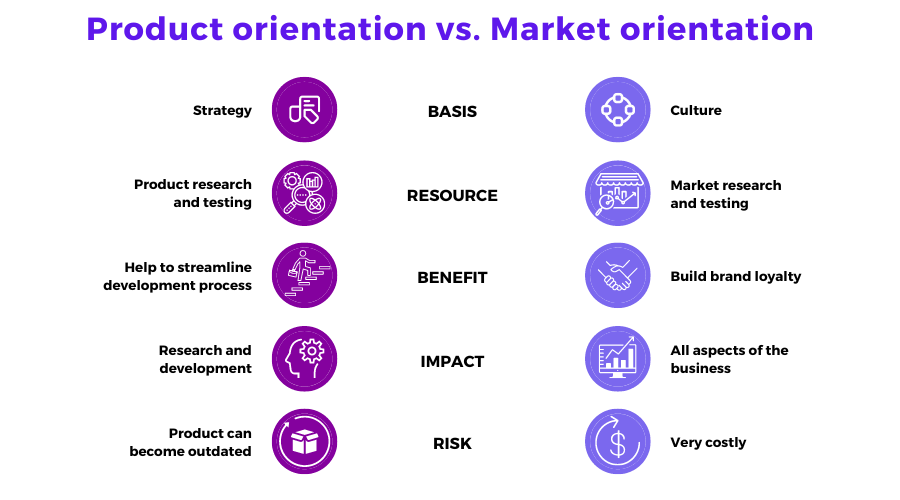What Is Product Orientation? (Definition and Meaning)
July 5, 2022 Max 7min read

Product Orientation Definition
Product orientation is a marketing management concept that emphasizes the promotion of high-quality items to increase sales. The corporation considers product quality to be a determinant of market demand. A product-oriented corporation focuses on creating high-quality articles and pricing them appropriately so that customers can recognize and acquire the company’s products.
What is Product Orientation?
Product orientation was relatively standard until the mid-twentieth century, mainly because consumers didn’t have many options for specific things.
The emphasis was on the product itself during the end of the nineteenth and early twentieth centuries. As a result, companies developed high-quality, competitive goods with various characteristics.
Customers have long placed a premium on quality, but the flaw in this approach was that the items didn’t always meet their needs.
Because product orientation emphasizes design and is frequently associated with research and development, it’s no surprise that many product-oriented businesses are technology firms.
The product has to sell itself, with a strong emphasis on research and development. As a result, it is only essential in a small market situation and is frequently paired with market orientation to appeal to a broad market.

A product orientation is a business strategy that dates back to the 1920s, when product development was less sophisticated, and the only focus was on creating high-quality products.
Product research, product development, and product focus are the three most essential techniques in product orientation.
To craft amazing products, you will need amazing tools. The ideal product management system like Chisel has all these tools. Check it out.
A product orientation is frequently referred to as the “no fear approach” because it implies that the company is bold, proactive, and risk-averse.
Isn’t it fascinating?
This strategy is in use by high-tech and innovative enterprises. Rather than the other way around, they want to teach consumers how to meet their product requirements.
Product Orientation vs. Market Orientation
Now that we know what it is, let’s look at market orientation and how it differs from product orientation.
This is a business culture that prioritizes client happiness.
The company guarantees that its values, norms, conduct, and the established processes, structures, and control inside the organization are by the customers’ needs.
So the reaction is based on what the consumer wants.
The attention shifted to the market and the clients’ needs within each market group soon.
Customers began to prefer customized products over time, and this orientation met that need.
Customers’ demands and desires became the focal point of whatever a firm tried to achieve, resulting in high-quality, personalized products that set them apart from their competition.
The focus of market orientation:
- What clients want.
- Developing and maintaining customer relationships.
- Keeping track of data for evaluation and study.
- Creating a link between client needs and organizational capabilities.
Many companies are interested in individuals who can speak to and persuade clients while also generating profit for the company. Product and market orientations are the talents individuals acquire to maintain a company’s profitability.
So you can see why both of these factors are crucial!
The difference:
While product orientation focuses entirely on the product’s quality, market orientation concentrates on the wants and satisfaction of customers.
Production orientation began in the middle of the 1950s, when items were in a limited stage of development, whereas Market orientation began around 1990 when businesses needed to make money.
Product research, product testing, and product focus are methods utilized in product orientation. Market research, market testing, and customer focus, on the other hand, are techniques used in market orientation.

Chisel provides a quick and easy way to conduct product feedback surveys. The pre-built survey templates from our library can be customized to suit your needs.
You can survey an audience you already have or survey a precise customer segment of your choosing via our audience panel.
Product orientation is a culture of product quality and rate setting, whereas market orientation is a business culture.
Using the product orientation strategy, a company attempts to create high-quality items that appeal to customers. An organization that uses the market orientation approach, on the other hand, attempts to understand customers’ demands and respond to them in the best possible way, therefore satisfying customers.
Product Orientation is in companies such as Gillette, Coco-Cola, Travis Perkins, and many others. Companies such as Amazon, Starbucks Coffee, Singapore Airlines, and many others fall into the market orientation category.
There is no “correct” method to run a company. Every day, business leaders suffer from a slew of critical decisions, and how they make these decisions can significantly impact strategic development, business perspective, and, ultimately, sales.
While a firm can use various marketing methods, they must align with the company and product goals, structure, and capabilities. Business people can pick between market orientation, product orientation, and sales orientation with the support of business strategists.

Why Is Product Orientation Important?
Product Orientation refers to a company’s emphasis on a single product, ensuring the achievement of the highest quality and performance.
The company splurges a lot of money on product development and research to ensure that the product sells itself, and they feel that as long as the product is of excellent quality, people will buy it.
By its very nature, continuous innovation allows a company to be the first to market in a new industry and, more crucially, to keep that edge.
Furthermore, organizations that consistently demonstrate their innovation ability tend to have a difficult-to-replicate brand following.
What Are the Advantages and Disadvantages of Product Orientation?
When sales drop, companies with this focus respond by increasing output and lowering prices. In cases where consumer demand exceeds supply, this attitude is highly effective.
After thoroughly analyzing and connecting with its target customers, it seeks to boost sales by providing clients with what they believe they require.
A few advantages are as follows:
- It enables a corporation to devote all its attention to a single product, ensuring that only the highest quality is delivered.
- Companies utilize economies of scale to achieve optimum efficiency at the lowest possible cost.
- Customers can tell you how to make your product through focus groups, questionnaires, polls, and other market research.
- Because a corporation focuses solely on one product, the manufacturing process is more straightforward.
- Customers benefit from low prices.
- Salespeople are an essential part of the product development process of a product-oriented organization. You don’t hire salespeople after you’ve decided to add a new product or change an existing one. You bring them in to find out what customers are saying, what objections lead to rejections, and other information about your and your competitors’ products.
A Product Orientation is one of the orientations in which businesses first concentrate solely on product quality. In a nutshell, companies produce high-quality goods at a specific price.
A few disadvantages are as follows:
- A great product does not always imply a good profit margin. A company may phase out if a competitor with the same product concentrates on consumer demands.
- Customers may or may not be fascinated by what you have to offer.
- Product obsolescence caused by technological changes and other market variables can lead to a company’s demise.
- Customers may not trust you to provide the items if you don’t have a solid reputation.
- A corporation that takes this approach will miss out on many market prospects.
- An ace product’s R&D costs could be high.
- To profit from a high-quality product, you may need to charge a more excellent price than the market would bear.
What Are Product Orientation Examples?
Many businesses utilize a combination of market and product orientation, with some emphasizing the latter.
These businesses are usually innovators who come out of nowhere with hot new products that consumers didn’t even know they wanted.
Are you curious as to which these companies are? Follow along to know more.
- The Gillette Company focuses on making the best disposable, eco-friendly razors at a minimal price. As a result, they set themselves separate with high-quality razor blades, ease of use, and an appropriate pricing plan.
- No one had fully imagined the iPod, iPhone, iPad — iAnything — before Steve Jobs and the Apple team rose to the level of tech fame that the business has today. Jobs and his team could profit from these and other revolutionary new items by delivering things they correctly projected would be in high demand.
- Another great example is Henry Ford’s Ford Motor Company, which produced only black-colored automobiles regardless of public preferences.
You may also like:
- What Is Strategic Marketing and Its Process?
- What is Product Management?
- The Smart Guide to Product Security
- What Is Market Positioning? Definition and Examples
- What Is Product Customization? (Benefits and Importance)
- What is Product Modification? (Definition & Examples)
- What is Product Line, and How to Create One? (With Examples)
FAQs
One of the critical concerns is that companies with a strong product orientation risk losing customers and profits to competitors who offer more in-demand goods. They may waste their marketing dollars on products that do not meet the needs of their customers.
Apart from the examples above, fast-food restaurants such as Burger King and McDonald’s, which focus on producing thousands of burgers per day at a low cost, are another significant production orientation example.
